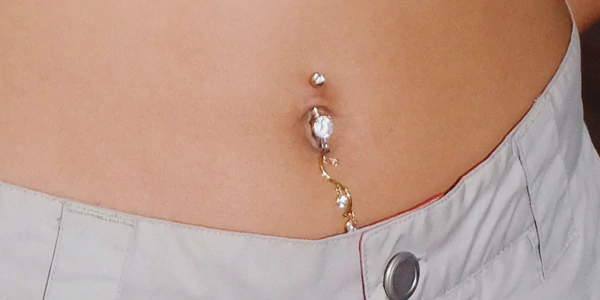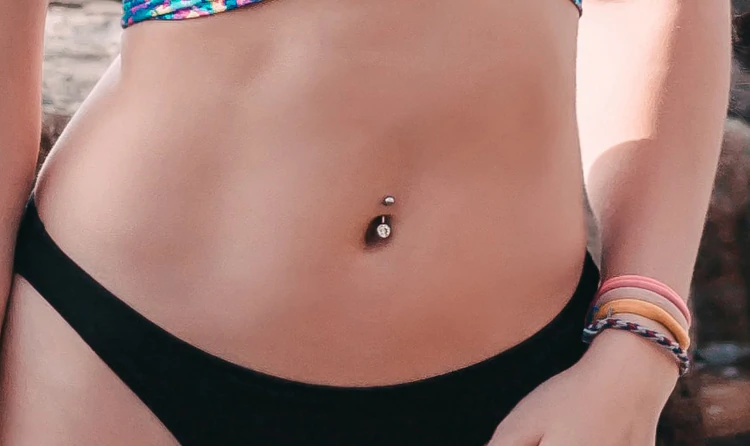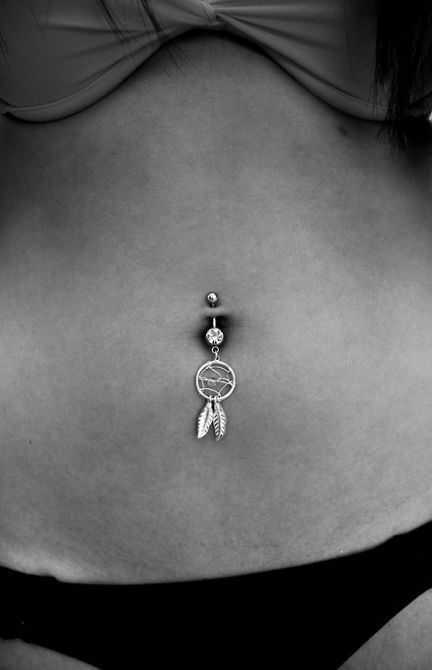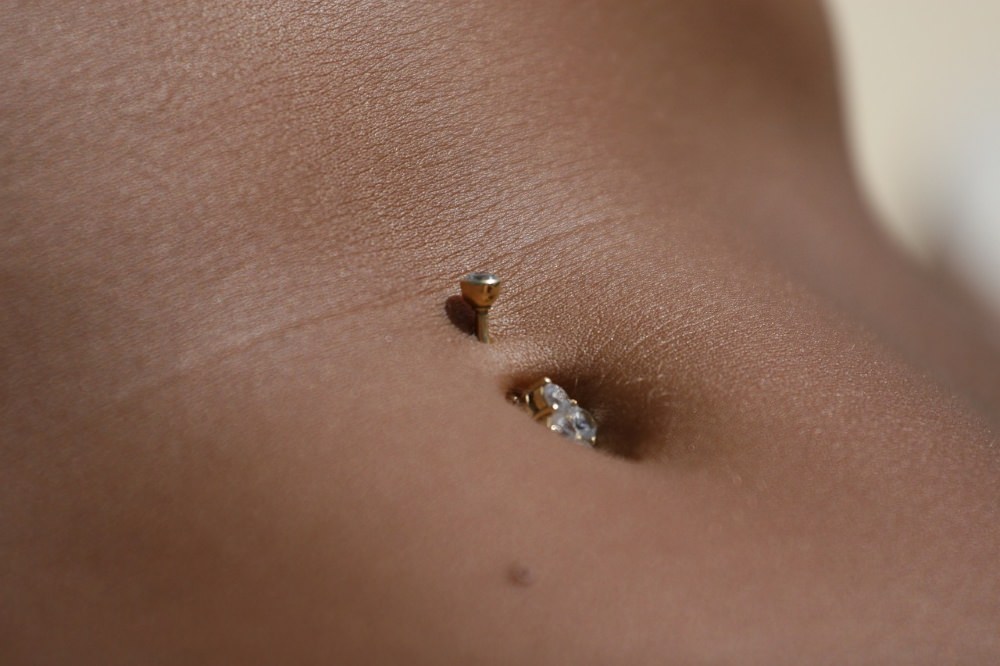About Jewelry Customization
- How to Choose the Correct Jewelry Factory OEM & ODM?
- Jewelry Factory Custom &Wholesale Silver/316L Stainless Steel Viking Ring
- From Your Idea to Samples and Mass Production
- How to customize jewelry at Churinga Jewelry Factory?
- How ensure the security of customer-customized jewelry?
- How to contact us (Churinga Jewelry Factory)Custom Jewelry, Jewelry Supplier, Wholesale Jewelry
- Stainless Steel Jewelry Manufacturer,Stainless Steel Jewelry Factory
- Jewelry Mass Production Companies in Churinga Jewelry Factory
- 18K Gold-Plated Jewelry
Most people encounter a lot of rejection in their lives – romantically, socially or even when trying to land a job. You never think you’ll have to add your rejected belly button piercing to that list, but it can happen.
Belly button piercing rejections aren’t always that easy to spot though. How do you know when your beautiful belly button piercing is about to go up in smoke? Furthermore, does that mean you’re destined to have a bling-less belly for the rest of your life?

What Is Belly Button Piercing Rejection?
A belly button piercing rejection is when your body wants to evict a piece of jewelry and starts to make that happen. It can be annoying and disheartening, but it’s also really kind of fascinating when you think about it.
Here’s what happens during the piercing rejection process. Your body starts ejecting the piece of jewelry. As it slowly works the jewelry out of the body, the skin starts to heal behind it. It’s very similar to what your body would do with a splinter, glass, or any foreign substance.
Although the difference is that you’re glad when your body repels a splinter but you want it to accept your piercing.
It may be hard to have a lot of appreciation for what the body can do when it’s rejecting something you desperately want, but it is amazing stuff.

How Much Does The Belly Button Piercing Hurt?
Since the skin around the navel is quite fleshy, belly button piercings hurt less than other piercing types, like cartilage piercings. However, you are receiving a puncture hole, so there will be some pain involved. Most claim that the navel piercing pinches similarly to an immunization. If you don’t have problems getting shots, then you should be fine. The good news is that the process is quick, and any initial piercing pain will be brief.
In the days after you receive your belly piercing, you’ll most likely feel some discomfort, including swelling, throbbing, and some aching. This is normal. If the piercing pain becomes too much to bear, speak to a medical professional.
Navel Piercing Healing Process
The navel piercing takes some time to heal. In a matter of weeks, it will appear healed, but it takes between 3 to 6 months for the piercing to heal internally. During that time, you need to keep up aftercare practices, including avoiding swimming. In some cases, it takes up to a year to completely heal, so make sure to talk to your piercer before stopping aftercare practices.
How Much Will It Cost?
A belly button piercing will cost anywhere between $30 and $70. As with any piercing, opt for experience over price. Never choose a piercer who uses a piercing gun. With belly piercings, it’s important that your piercer understands the correct jewelry size to use in order to avoid rejection, so it’s important that you choose an expert piercer.

Belly Piercing Variations
You might think that the belly button piercing is pretty straightforward, but there are variations to this popular piercing.
- The bottom belly button piercing pierces the skin below the belly button, rather than above. This piercing is great for those who would prefer jewelry that hangs lower than the standard belly piercing.
- The double belly button piercing allows for a bit of variety. Essentially, it consists of an additional piercing either above, below, or to the side of your belly button piercing. Vertical double piercings seem to be the most popular. The vertical double belly piercing consists of a regular belly piercing and the bottom belly button piercing. You can choose a standard belly ring for each piercing, creating an alluring aesthetic. You can also get creative with charms and dangles to create a stunning cascading effect.
How Common Is It For a Belly Button Piercing To Reject?
Belly button piercing isn’t common, but quite a few people tend to experience such a unique rejection. Your belly button rejecting a piercing is more likely when your family has a history of piercing rejection.
If a close family member experienced the same issue, it’s highly probable that you’ll experience it as well. This should encourage you to be cautious while getting a belly button piercing. If you’re prone to allergic reactions, especially from poor quality jewelry, you’re more likely to face belly button piercing rejection. Such rejections may lead to bigger problems such as infections, making it difficult for you to get another piercing. If you know that you have allergies, stick to high-quality jewelry such as 14k gold and titanium nickel-free.
If you’re going through a difficult time with your bodily changes and see a sudden change in your body weight, belly button piercing rejection will be more likely. When facing bodily changes, your skin starts to stretch, especially during pregnancy, which greatly affects your belly button piercing. You don’t necessarily need to experience belly button piercing rejection, even if you can relate to the factors mentioned above, but this way, you can be more alert and avoid such a frustrating situation.
What Causes A Rejected Belly Button Piercing?
Your skin is the largest organ in your body and the only one that comes into contact with the outside world. It holds in all your bodily fluids and keeps out harmful microbes that cause infections.
When your skin is injured, it goes through a complex process of healing that begins with inflammation and ends with the formation of scar tissue.
Your body will only build up scar tissue around a piece of jewelry if that process is easier than pushing out the jewelry entirely. In the case of surface piercings, the body is often tempted to push out the jewelry rather than wall it off with scar tissue.
Part of wound healing involves contraction, which means your skin is pulling itself back together. This is what allows holes to close up when jewelry is removed.
There’s no specific cause that leads to piercing rejection. It happens due to a combination of factors, including:
- Genetics. Some people heal differently than others.
- The skin surface. Flat surfaces are more prone to rejection.
- The tautness of skin. Piercing into tight skin around the belly button or chest puts more pressure on the piercing to hold the skin together (like a staple).
- The size and shape of the jewelry. Ill-fitting jewelry is often the initial cause of migration.
- The material of the jewelry. Some materials, such as titanium, may be better for those with sensitive skin and can reduce the likelihood of an allergic reaction or rejection. Your piercer can recommend the right jewelry for you and the location of your piercing.
- Weight changes. Pregnancy and obesity cause the skin to stretch, which may put pressure on the piercing.
- Physical or emotional stress. A healthy, strong immune system is important for the healing process — and too much stress can negatively affect it.

Common Signs & Symptoms Of A Rejected Belly Button Piercing
If you’ve really paid attention to your piercer about what’s normal and what isn’t following a piercing, you may be able to spot a rejection in its early stages.
You should keep in mind that just because you’ve made it through the first few months, you shouldn’t feel overly confident. Belly button piercing rejections can happen at any point – even months or years after you’ve had the piercing done.
Due to the fact that they can happen so slowly, you might think you’re out of the woods, even if you’re not.
Here are some of the signs you might notice if a rejection begins:
Migration Happens
Migration is when your belly button jewelry is slowing pushed closer toward the surface of your skin. Some migration is normal and isn’t a reason to panic. Though, you should still have it checked out by your piercer to see if it’s concerning or normal.
If you notice the migration appears to be continuing, it’s not a good sign. That’s an indication your belly button piercing is going to be rejected.
Over-the-Top Soreness
Obviously, you aren’t going to make it out of a belly button piercing without some soreness. That’s to be expected, and just because you’re feeling tender or sore, it doesn’t mean rejection is happening.
However, if you start to have soreness that has gotten worse without any signs of infection, it could signal a rejection. If your skin also feels super sensitive and you’ve already been through the initial healing phase, it could signal a rejection too.

Another sign that something is going wrong, is when it’s been months after your piercing and the pain seemed to go away, but lately, it has been resurfacing.
If the pain only lasts for one day, you shouldn’t sweat it too much. It could just be that your belly button jewelry got snagged on your clothes and was pulled a bit, leading to the pain.
Still, if the soreness is a new thing for you and seems to be consistent, watch out for any other symptoms of a belly piercing rejection or an infection.
You Can See It With Your Own Eyes
If you start to notice the bar on your belly button piercing jewelry is visible through your skin, that’s a big clue migration is happening. As migration is underway, that bar inside your body will keep moving closer to the surface until it actually is so close to the surface of your skin that you can it.
It’s Hanging Loosely
When rejection is underway, the jewelry won’t seem as tight as when you first got it. It will seem like it’s hanging there loosely.

Increase In Piercing Hole Size
If you notice the holes at the piercing sites getting bigger, you should watch for other signs of rejection. This is a common one and it might be one you’ll only notice if you pay close attention to your navel.
More Discharge
In the first few days or even couple of weeks after your piercing, you can expect discharge. Nevertheless, if the discharge seems to slow down and then start back up, it could mean your piercing is being rejected.
Formation of a Keloid Or Scar
If you see a formation of scar tissue around your belly button piercing, you should have it checked out. A hypertrophic scar or keloid is an overproduction of scar tissue that builds up around the area of trauma. They don’t typically contain pus or fluid and aren’t painful, although a keloid may be tender to touch.
Keloids can be big or small. Although the size of them might matter to you, it still signifies the same thing no matter how large they are – your body has formed scar tissue as a result of the piercing, which could point to a rejection.

How to stop the process of rejection?
If the piercing appears to be migrating toward the surface, take the following steps:
- Remove the jewelry and contact the piercer. Keeping the jewelry in increases the chances of scarring. A large scar can prevent a person having a new piercing in the same location after it heals.
- Ask the piercer about using a different piece of jewelry. Thicker-gauge jewelry or a different shape or material may help the piercing heal and settle into place better.
- Do not try to treat the rejection at home with bandages or coverings. This may slow healing and has not been shown to help keep piercings in place.
Can You Fix A Rejected Belly Button Piercing?
If you do have a belly button piercing rejection, are you doomed to never have the belly button jewelry you want to wear? Or is it a temporary setback? It depends on whether you can save your current piercing.
If you want to have any chance of saving it, you need to watch for any signs of rejection. If you see anything concerning, have it checked out quickly. If you wait until your piercing has migrated so far that you can see the jewelry through the skin, the best course of action is to have that area re-pierced at a later date. Obviously, cleaning your belly button piercing regularly and thoroughly will help to prevent any further complications from arising.
It can be frustrating when your body rejects a piercing, but there’s no danger other than scarring (unless there’s a severe infection). The best thing to do is prevent the jewelry from pushing itself through the skin’s surface. If the jewelry cracks open your skin’s surface, it’ll cause more damage, which means more scar tissue. Excessive scar tissue at the piercing site makes re-piercing difficult. Here are a few tips for dealing with piercing migration and rejection:
- Take out the jewelry if you see it migrating toward the surface.
- Try a new piece of jewelry in a different size, gauge, shape, or material.
- Speak with a qualified piercer for advice.
- Opt for a nonirritating plastic ring or bar.
- Try a larger piece of jewelry if your ring won’t lie flat or your barbell looks like it’s getting swallowed up.
- Wait about a year before re-piercing.
- Apply a topical vitamin E oil to reduce the appearance of scars.
How Can You Avoid Belly Button Piercing Rejections?
It can be frustrating when your body rejects a piercing, but there’s no danger other than scarring (unless there’s a severe infection). The best thing to do is prevent the jewelry from pushing itself through the skin’s surface. If the jewelry cracks open your skin’s surface, it’ll cause more damage, which means more scar tissue. Excessive scar tissue at the piercing site makes re-piercing difficult.
Here are a few tips for dealing with piercing migration and rejection:
- Take out the jewelry if you see it migrating toward the surface.
- Try a new piece of jewelry in a different size, gauge, shape, or material.
- Speak with a qualified piercer for advice.
- Opt for a nonirritating plastic ring or bar.
- Try a larger piece of jewelry if your ring won’t lie flat or your barbell looks like it’s getting swallowed up.
- Wait about a year before re-piercing.
- Apply a topical vitamin E oil to reduce the appearance of scars.

Summary
It can feel like a big defeat when you pay for your piercing and go through all the pain and discomfort associated with it only to have your body reject it.
However, if you really want something badly enough, you might decide to keep trying, and if you do, you just might end up with want you wanted all along – a cool belly button ring to show. If you want to ensure your piercing heals the best it possibly can, it’s imperative that you follow your piercer’s aftercare advice closely, and be sure to invest in a high-quality aftercare solution to aid recovery.
The best piercing aftercare product I’ve ever had the pleasure of using up to this point is the After Inked Piercing Aftercare Spray. Not only is it vegan-friendly, but it’s also completely alcohol and additive-free. The solution works well on all skin types including sensitive skin, and it comes in a generously-sized mist-spraying bottle for easy application. When using it from the very start of the healing process, the spray helps to decrease healing times and aims to eliminate any lingering pain or soreness.
Ten articles before and after
Belly Button Piercing Bleeding | CHURINGA Belly PIERCINGS
How to Clean Belly Button Piercing Jewelry | CHURINGA Belly PIERCINGS
How Long Does A Belly Button Piercing Take To Heal? | CHURINGA Belly PIERCINGS
Swimming With A New Belly Button Piercing | CHURINGA Belly PIERCINGS
Belly Button Piercings: Healing & Aftercare | CHURINGA Belly PIERCINGS
Belly Button Piercing Scars: Causes and Treatment | CHURINGA Belly PIERCINGS
Infected Belly Button: 5 Ways to Tell and What to Do About It | CHURINGA Belly PIERCINGS
How To Take Out A Belly Ring | CHURINGA Belly PIERCINGS
When Can I Change My Belly Ring? | CHURINGA Belly PIERCINGS
Can You Re-Pierce A Belly Button? | CHURINGA Belly PIERCINGS
